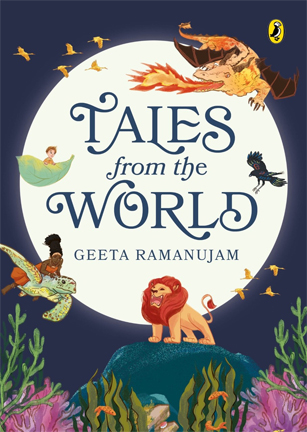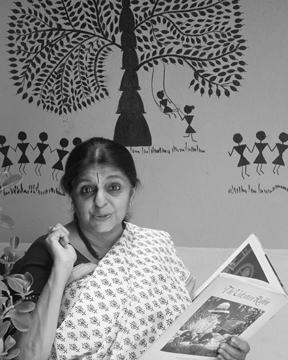Chintan Girish Modi

Did you know that storytelling can be pursued as a profession? Geeta Ramanujam, the founder and executive director of the Kathalaya Trust in Bangalore, is a professional storyteller. She has also trained people in various parts of the world to take up storytelling as a career or incorporate it into their work. Her trainees include teachers, parents, doctors, counsellors, entrepreneurs, lawyers, theatre practitioners and corporate executives.
She founded her organization in 1998 to use storytelling for social change. Her new book Tales from the World (2022) is an excellent resource for readers who want to take baby steps on this journey. It builds on over two decades of committed work. In this book, published by Puffin, she has compiled stories from India, South Africa, Tibet, Japan, Russia, Scotland, Ghana, China, France, Korea, Sweden and the United States of America.

The story behind how she became a storyteller is also presented in this book. She writes, “My father read aloud in English and my mother told me stories in Tamil…. Listening played a predominant part in my upbringing, be it tales, music, songs, cultural programmes or movies.” She was exposed to theatre. She also learnt Bharatanatyam and Carnatic classical music. In addition, she read “cheap, well-illustrated, easy to read” Russian children’s books.
This book brings together stories that she has heard in village fairs, at storytelling festivals, around fireplaces, in libraries, and on porches attached to people’s homes. Some of these are folk tales; others are from epics. Some are contemporary; others are ancient. Some are creation stories and origin myths; others are about death, the afterlife and spirits. Some have multiple versions. She explains, “When a story begins in one place but travels across the vast expanse of the earth, growing and changing as stories often do, you know it’s a good one.”
Her career began as a kindergarten teacher. Later, she taught social studies and English to older students. She writes, “When I became a teacher and a librarian in 1980, my instant recipe to make concepts interesting would be a story.” She has come a long way and now heads Kathalaya’s International Academy of Storytelling. Read the book to enjoy her stories, accompanied by Arkapriya Koley’s vibrant illustrations. The book was written over three years, with three editors, based on notes in the diary that she has maintained since 1990.
We bring you an interview with the author.
Question: You describe yourself as “a wanderer by heart, who travels, cares, collects, shares and tells stories to spread peace, harmony, love and friendship wherever she sets foot.” When and how did you come to see storytelling in this expansive manner?
Answer: My very first storytelling session as a trainer and performer took me to Madurai. This happened soon after I got an Ashoka fellowship to duplicate storytelling in several areas around India. They funded me for this creative idea. That took me to different states of India – from tribal areas to mountainous ones, from coastal areas to desert regions.
In the meanwhile, I also had offers to travel to Japan and South Africa to use storytelling as a tool to learn about and address specific issues in the fields of education and learning. This is how I began to travel a lot. It seemed to gel with my heart which already felt like a wanderer.
I thought that one way to sustain children’s attention and interest in learning, get them interested in concepts and subjects, could be “the story way”. After all, I grew up learning most of my lessons and values listening to my parents and teachers tell tales.

Your journey as a storyteller began as a teacher and librarian. What differences did you notice between the school curriculum and what children read for fun?
I noticed that children would pick up tales of adventure, fantasy and spooky tales to read at leisure. They would like listening to tales from classics like A Tale of Two Cities by Charles Dickens, Wuthering Heights by Emile Bronte, The Mill on the Floss by George Eliot, and Malgudi Days by R. K. Narayan. These were part of their non-detailed reading that did not have homework but created an awareness for characters, places and historical settings.
They also loved to listen when I read aloud books like The Trumpet of the Swan by E.B White, Charlie and the Chocolate Factory by Roald Dahl, and later Oliver Twist and David Copperfield – both by Charles Dickens to understand the Industrial Revolution in England. Autobiographies of Charlie Chaplin, Mahatma Gandhi and others helped them to understand legends and heroes. Ruskin Bond’s books tempted them to travel to the Himalayas to see and feel the trees and the climate as was described in detail by him. R.K Narayan’s tales opened up their interest in Karnataka and the local food habits and cultures.
How do you look back on your journey as a professional storyteller with over two decades of experience? What keeps you engaged in this work after so many years?
Listeners and participants feeling calm, clapping and having a gleam in their eyes – whether they are adults or children – this is what keeps me going. One can feel the genuine love and warmth as they leave the hall after a training or a performance not only in India but around the world. Most participants have talked about feeling “transformed ” after my sessions. This motivates me to reinvent the same story and tell it in differing styles, with new elements. Divinity combined with unconditional love helps me to carry on this journey, which I feel is entrenched deep in my heart. Love and spirituality light up my journey.
Teachers often struggle to hold the attention of their students while telling stories. Do you have a different set of recommendations for online and offline classes?
Yes, one of my training modules deals with 10 different ways of captivating the attention of listeners. In offline sessions, one could freely use the body language, mime or movement to introduce a tale. In online sessions, the movement is restricted so one can use more riddles, pictures, puppets, sounds and actions to capture the attention. What is most important – both offline and online – is the interest combined with motivation and energy.

How can teachers use stories to connect with students who find it difficult to express their emotions?
I train special educators and children with difficulties in speech. One has to work without expectations. Explicit responses may not be easy from some children but they do respond inwardly. When we continue to tell stories using props, puppets, voices and sounds, one can see a little gleam in the children’s eyes and there may be other ways which help them express; for instance, coming closer to the teller. Once when I told stories to children with Down’s syndrome, I had no response from them but I did my telling equally energetically with props and pictures. As I packed my bag and approached the door to leave, one of the children in that session caught my leg as if to say, “Please don’t leave us.” It was touching.
Anything else that you’d like to add?
This book has my favourite tales which I use for training teachers, and in sessions with children. The stories in this book are not meant only for the 8-11 age group but every story has many layers and subtly conveys multiple meanings to readers ranging from children to adult audiences including senior citizens. Having a collection of over a 100 tales from 48 countries, I intend to bring out another book soon. I would also like to work on one about my travel experiences with glimpses of a storyteller’s life, full of rare and beautiful moments.
The author is a Mumbai-based journalist who loves reading and reviewing books. He can be reached at chintan.prajnya@gmail.com.
